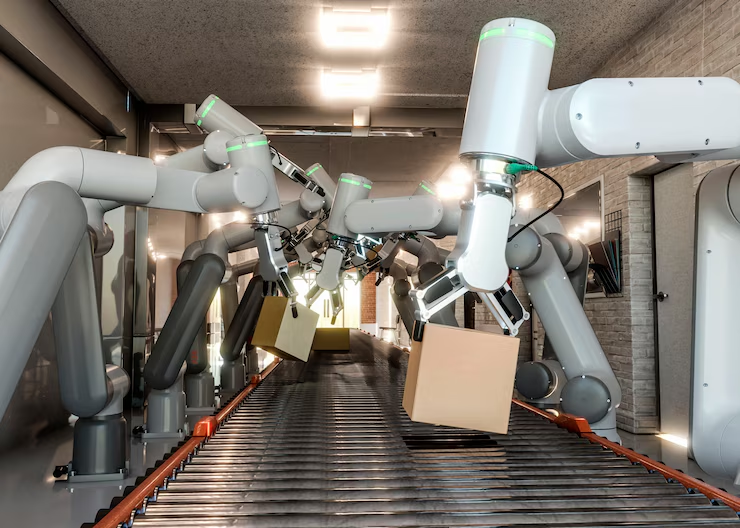TECHNOLOGY
Transforming Paper Manufacturing Through Industrial Automation

In the competitive and resource-intensive world of paper manufacturing, efficiency, consistency, and sustainability are paramount. With the industry facing pressures from both environmental regulations and market demands for higher quality products, many paper manufacturers are turning to industrial automation to enhance their production processes. Among the myriad technologies revolutionizing this sector, servo controllers play a crucial role by ensuring precision and efficiency in automated systems. This article explores the significant impact of industrial automation on paper manufacturing, emphasizing how servo controllers contribute to optimizing operations.
The Importance of Automation in Paper Manufacturing
Paper manufacturing involves various complex processes, from pulp preparation to the final rolling and cutting of paper. Each stage must be meticulously controlled to ensure product quality and process efficiency. Industrial automation brings several critical improvements to these processes:
- Enhanced Production Efficiency
- Automation allows for the continuous and consistent operation of paper mills, significantly increasing production rates and reducing downtime. Automated systems can manage tasks such as paper grading, cutting, and packaging more quickly and accurately than manual operations.
- Improved Product Quality
- Consistency in product quality is crucial in the paper industry. Automated control systems ensure precise conditions during the papermaking process, such as maintaining exact humidity and temperature levels, which are vital for producing high-quality paper.
- Increased Cost Efficiency
- While the initial investment in automation technology can be high, the long-term savings are substantial. Automation reduces labor costs, minimizes waste, and increases material efficiency by precisely controlling raw material use and reducing overruns and defects.
- Enhanced Environmental Compliance
- Automation helps paper mills reduce their environmental impact by optimizing energy use and reducing waste. Automated systems can adjust production processes in real-time to use the minimal necessary resources, helping to meet stringent environmental regulations.
Key Applications of Industrial Automation in Paper Manufacturing
- Pulp Preparation
- The first step in paper manufacturing is preparing the pulp. Automation technologies control the chemical mix and cooking times in the pulping process, ensuring consistency and quality in the pulp produced. Servo controllers manage the precise movements of machinery that mix, cook, and transfer the pulp, enhancing both safety and efficiency.
- Paper Machine Operations
- In the paper machine, pulp is formed into thin sheets and dried. Servo controllers are integral here, as they precisely control the speed and tension of the paper as it moves through the machine. This precise control is crucial for ensuring the paper maintains uniform thickness and strength across large production runs.
- Coating and Finishing
- Many types of paper require coating for additional quality features, such as glossiness or ink absorption. Automated coating machines, regulated by servo controllers, apply exact amounts of coating materials uniformly across the paper surface. This precision is essential for meeting specific product specifications and reducing material waste.
- Cutting and Packaging
- Finally, large rolls of paper must be cut to size and packaged. Automation in these final stages includes using robots for handling heavy rolls and precise cutting machines for trimming the paper to size. Servo controllers ensure that these cuts are precise and that the packaging machinery operates efficiently, further optimizing the end stages of the manufacturing process.
The Role of Servo Controllers in Paper Manufacturing Automation
Servo controllers are crucial in the automation of paper manufacturing processes. These devices manage the operation of servo motors that drive the majority of the automated machinery used in the industry. Here’s how they contribute:
- Precision Control: Servo controllers like 3-100-7-FW allow for fine adjustments in machinery, which is vital for tasks requiring high precision, such as maintaining the tension of the paper sheet through the drying section or precisely cutting finished rolls to exact dimensions.
- Flexibility: These controllers can be quickly reprogrammed to accommodate different types of paper or to switch between various product specifications, providing the flexibility needed to respond to changing market demands.
- Efficiency: By optimizing the movement of production machinery, servo controllers reduce cycle times and enhance the overall efficiency of the production process.
Challenges in Automating Paper Manufacturing
Despite the advantages, automating paper manufacturing presents several challenges:
- High Initial Investment
- The cost of implementing state-of-the-art automated systems can be prohibitive, particularly for smaller manufacturers.
- Technical Complexity
- Developing and maintaining sophisticated automated systems requires a high level of technical expertise, necessitating ongoing training and development for operational staff.
- Integration with Legacy Systems
- Integrating new automation technologies with existing equipment and systems can be complex and time-consuming, requiring significant adjustments and sometimes leading to operational disruptions.
Conclusion
Industrial automation, particularly through the use of advanced servo controllers, is playing a transformative role in the paper manufacturing industry. By enhancing precision, efficiency, and sustainability, automation helps manufacturers meet the challenges of modern paper production demands. As technology continues to evolve, embracing these innovations will be crucial for maintaining competitiveness in a global market and achieving the high standards required in today’s paper industry. The integration of such technologies not only supports current manufacturing needs but also paves the way for future advancements, driving the industry toward more sustainable and efficient practices.
TECHNOLOGY
Exploring miuzo: The next big thing in digital innovation

Welcome to the world of miuzo, where digital innovation meets groundbreaking technology. As we navigate an ever-evolving landscape filled with gadgets and apps, miuzos stands out as a beacon of progress. Imagine a platform that not only enhances your everyday life but also redefines how we interact with technology. With its unique capabilities and user-friendly interface, miuzo is more than just another tool; it’s a transformative experience waiting to be explored. Dive in as we unravel the essence of miuzos and discover why it might just be the next big thing in digital innovation.
The Technology Behind miuzo
At the core of miuzo lies cutting-edge technology that drives its innovative capabilities. This platform combines artificial intelligence and machine learning to create an intuitive user experience.
Miuzos processes vast amounts of data with unmatched speed, adapting to individual needs seamlessly. Its algorithms enable personalization, making every interaction unique.
Additionally, miuzo leverages cloud computing for scalability and efficiency. This means users can access features anytime, anywhere without lag or interruption.
The integration of blockchain technology enhances security and transparency in transactions. Users can rely on robust safeguards against unauthorized access.
Moreover, the user interface is designed with simplicity in mind. Even those unfamiliar with tech can navigate it easily.
This blend of technologies positions miuzos as a frontrunner in digital innovation while paving the way for future advancements across various sectors.
Key Features and Benefits of miuzo
miuzo stands out with its user-friendly interface. This accessibility ensures that users of all technical backgrounds can navigate the platform effortlessly.
One of its standout features is real-time data processing. This allows businesses to make informed decisions quickly, adapting to market changes almost instantly.
Security is another priority for miuzos. Advanced encryption protocols safeguard sensitive information, giving users peace of mind.
Seamless integration with existing tools enhances productivity by streamlining workflows. Businesses can connect various applications effortlessly, reducing time spent on manual tasks.
Additionally, customizable analytics provide insights tailored to specific needs. Users can track performance metrics crucial for growth and optimization.
These key features collectively position miuzos as an essential tool in the digital ecosystem, driving innovation while delivering tangible benefits across industries.
How miuzo is Changing the Digital Landscape
miuzo is redefining how we interact with digital platforms. By integrating advanced algorithms and user-friendly interfaces, it enhances user experience like never before.
With its innovative approach, miuzo empowers businesses to engage customers more effectively. This shift allows for personalized content delivery that resonates with users on a deeper level.
Moreover, miuzo promotes seamless integration across various devices and applications. Users can access services effortlessly, breaking down barriers that once hindered connectivity.
The rise of miuzo also inspires creativity among developers. It encourages them to explore new possibilities in app design and functionality.
As companies adopt this technology, traditional methods are being replaced by smarter solutions. The entire digital landscape is evolving rapidly as a result of these advancements.
Real-life Applications of miuzo
miuzo is making waves across various sectors. Its versatile applications are transforming how businesses operate.
In healthcare, miuzo streamlines patient management systems. By centralizing data, it enhances communication between doctors and patients. This leads to better treatment outcomes and increased efficiency.
Education is another area where miuzo shines. It offers innovative tools for personalized learning experiences. Teachers can tailor lessons based on student needs, fostering engagement and improving academic performance.
Retail also benefits from miuzo’s capabilities. With real-time analytics, retailers can optimize inventory management and enhance customer experiences through targeted marketing strategies.
Even in environmental initiatives, miuzo plays a role by providing solutions for monitoring sustainability efforts. Organizations can track their carbon footprint more effectively with the technology’s robust data analysis features.
The potential of miuzo continues to expand as industries discover new ways to leverage its strengths in everyday operations.
The Future of miuzo and its Impact on Society
The future of miuzo promises to reshape how we interact with technology. As it evolves, its ability to integrate seamlessly into daily life will redefine convenience and efficiency.
Imagine smart cities powered by miuzo’s capabilities, where traffic flows effortlessly and energy consumption is optimized. This innovation could lead to sustainable living environments that minimize waste while enhancing quality of life.
Moreover, the potential for personalized experiences is vast. miuzo can adapt services based on individual preferences, making interactions more engaging and relevant.
Education stands to benefit significantly as well. With tailored learning experiences driven by this technology, students can access resources that match their unique learning styles.
As society embraces these advancements, ethical considerations will emerge. Prioritizing privacy while harnessing the power of miuzo will be crucial in ensuring trust between users and technology providers. The balance between progress and responsibility will define our collective digital future.
Conclusion
As we explore the dynamic world of miuzo, it becomes clear that this innovative platform is more than just a technological advancement; it represents a significant shift in how we interact with digital tools. By harnessing cutting-edge technology, miuzo provides users with an array of features designed to enhance productivity and creativity.
The impact of miuzo reaches far beyond individual users. Its applications are transforming industries and redefining standards for efficiency and collaboration. As communities adopt this groundbreaking solution, the potential for positive change grows exponentially.
Looking ahead, it’s exciting to envision how miuzo will continue to evolve and influence our society. With its commitment to innovation, there’s no telling where this journey will take us next or what new possibilities await on the horizon. Embracing platforms like miuzo could very well be a pivotal moment in our digital future—one filled with opportunities yet to be discovered.
TECHNOLOGY
The Ultimate Guide to Personalizing Your Space with wallapix

Your living space is a canvas, waiting for your unique touch. Enter wallapix, the innovative platform that transforms ordinary walls into extraordinary reflections of your personality. Imagine stepping into a room adorned with images capturing cherished memories, breathtaking landscapes, or vibrant artwork that speaks to you. With wallapix, personalizing your environment has never been easier or more enjoyable.
Whether you’re looking to create an inspiring home office, a cozy bedroom retreat, or an inviting living area full of warmth and character, wallapix offers versatile options tailored just for you. From customizable prints to various materials and formats, this tool empowers you to design spaces that truly resonate with who you are. Let’s explore how wallapix can help elevate your surroundings and make every corner feel uniquely yours!
Benefits of personalizing your space with wallapix
Personalizing your space with wallapix brings a fresh vibe to your home. It transforms blank walls into vibrant canvases that reflect your personality and style.
When you choose images that resonate with you, the environment becomes more inviting. A customized atmosphere fosters creativity and comfort, making it easier to unwind after a long day.
Additionally, personalized decor can spark conversations. Unique artwork or family photos often draw attention, allowing guests to connect over shared memories or stories behind the images.
Moreover, wallapix offers endless possibilities for customization. Whether it’s large-scale prints or smaller accents, the options allow for flexibility in design.
Creating a personalized look also boosts mental well-being. Surrounding yourself with cherished moments can evoke happiness and nostalgia every time you walk into the room.
How to use wallapix to create a unique and personalized look
Using wallapix is an exciting way to transform your space into something truly personal. Start by selecting images that resonate with you—whether they’re family photos, travel snapshots, or art pieces.
Once you’ve chosen your favorites, explore the various product options available on wallapix. You can create stunning canvas prints, custom posters, or even wallpaper featuring your unique designs.
The platform allows for easy customization of size and layout. Experiment with different arrangements until you find a configuration that feels just right for your room.
Don’t shy away from mixing styles and colors. A vibrant photo gallery can add depth to a neutral space while black-and-white images bring elegance wherever placed.
Consider incorporating text elements into your designs—a favorite quote or meaningful dates elevate the personalization factor further. Your walls will reflect who you are in no time!
Tips for choosing the right images for your space
Choosing the right images for your space can transform its atmosphere. Start by considering the room’s purpose. For a calming bedroom, opt for serene landscapes or soft abstract art.
Think about colors too. Select images that complement your existing decor and enhance the overall color scheme. Warm tones evoke coziness, while cool shades promote tranquility.
Don’t shy away from personal touches. Family photos or travel memories add character and warmth to any environment. These choices reflect who you are and make spaces feel inviting.
Size matters as well—large prints can serve as statement pieces, while smaller ones work best in clusters. Play with different arrangements before settling on a final layout to see what feels right in each area of your home.
Consider seasonal variations; swapping out images periodically keeps things fresh and exciting! Mixing styles also creates visual interest—just stay true to your unique taste throughout it all.
Creative ways to incorporate wallapix into different rooms
Transform your living room into a gallery with wallapix. Use large canvas prints to create a stunning focal point above the sofa. Choose family photos or breathtaking landscapes that resonate with your style.
In the bedroom, consider personalized photo collages on wall decals. They can surround your bed like an intimate storytelling piece, bringing warmth and personality to the space.
For home offices, custom motivational quotes paired with images of achievements can inspire productivity. Wallapix allows you to design these pieces uniquely suited to your aspirations.
Kitchens are perfect for fun and vibrant art pieces featuring food photography or culinary adventures. Brighten up the walls and make cooking feel even more enjoyable.
Bathrooms might seem tricky, but small framed prints or tiles showcasing serene nature scenes can add a spa-like atmosphere. Make every moment relaxing as you unwind in this personal oasis.
Testimonials from satisfied customers
Customers have shared their enthusiasm for wallapix, highlighting how it has transformed their living spaces. One user described the joy of seeing family memories come to life on their walls. The high-quality prints brought an emotional touch that was previously missing.
Another customer marveled at the ease of customization. They appreciated how simple it was to turn digital photos into stunning canvas art. This seamless process allowed them to express their creativity with minimal effort.
A third testimonial spoke about using wallapix in a home office. By personalizing the workspace with inspiring images, they found increased motivation and focus throughout the day.
These experiences underline how wallapix not only beautifies homes but also enhances everyday life through personalized touches that resonate deeply with individuals and families alike.
Conclusion
Personalizing your space can transform not only the look of your home but also how you feel within it. With wallapix, creating a unique atmosphere is both fun and easy. The platform offers an array of features that allow you to customize everything from prints to canvases.
As you explore ways to personalize your space with wallapix, remember that the right images are crucial in conveying your personality and style. Consider what resonates with you—whether it’s family photos, travel memories, or abstract art.
Integrating wallapix into various rooms opens up endless possibilities for creativity. Each room can tell its own story through carefully chosen designs and colors.
The experiences shared by satisfied customers show just how impactful wallapix can be in enhancing personal spaces. Their transformations serve as inspiration for anyone looking to make their living environments more inviting.
TECHNOLOGY
MataRecycler: Bridging Technology and Ecology in Waste Processing

Waste management is a pressing issue that affects communities worldwide. With millions of tons of waste generated daily, finding efficient and eco-friendly solutions has never been more critical. Traditional methods often fall short, leading to pollution and resource depletion. But what if there was a way to transform this challenge into an opportunity? Enter MataRecycler—a groundbreaking innovation at the intersection of technology and ecology designed to revolutionize how we think about waste processing. By harnessing advanced technologies, MataRecycler aims not only to streamline waste management but also to promote sustainability in our everyday lives. Let’s dive deeper into this transformative solution and explore how it’s reshaping the future of waste processing for good.
What is MataRecycler?
MataRecycler is an innovative platform designed to tackle the growing waste management crisis. It harnesses cutting-edge technology to create efficient solutions for processing various types of waste.
At its core, MataRecycler connects businesses and communities with advanced recycling facilities. This connection streamlines the collection and sorting of recyclable materials, reducing landfill contributions significantly.
The system employs smart algorithms that optimize routes for waste collection vehicles. By minimizing travel distances, it lowers carbon emissions while increasing efficiency in resource recovery.
Additionally, MataRecycler provides real-time data analytics to users. This transparency helps organizations track their waste output and make informed decisions about sustainability practices.
With a focus on eco-friendly operations, MataRecycler aims not just to recycle but also to educate on responsible consumption habits. The vision is clear: a cleaner planet through better waste management practices powered by technology.
The Role of Technology in Waste Processing
Technology plays a pivotal role in modern waste processing. It enables more efficient sorting, recycling, and disposal methods than ever before. With advancements in artificial intelligence and machine learning, facilities can now analyze waste streams with unprecedented accuracy.
Automated systems detect recyclables from general waste quickly. Robotics are increasingly employed to handle hazardous materials safely. This minimizes human exposure while maximizing recovery rates.
Data analytics also contribute significantly to optimizing operations. By analyzing patterns in waste generation, companies can implement better strategies for reduction and reuse.
Moreover, technology enhances public awareness about recycling practices through apps and online platforms. These tools inform users about local resources and encourage responsible consumption habits.
The integration of technology into the waste management sector not only improves efficiency but also fosters sustainability—a necessity for our planet’s future health.
How Does MataRecycler Work?
MataRecycler operates through an innovative blend of technology and sustainable practices. At its core, it utilizes advanced algorithms to identify and categorize waste materials efficiently.
Once the waste is collected, sensors scan for various types of recyclables. This ensures that everything from plastics to metals is sorted accurately. The data gathered helps optimize recycling processes in real-time.
Users can easily access the system via a user-friendly app. This interface provides insights into local waste management efforts and encourages community participation.
Moreover, MataRecycler promotes transparency by tracking where materials end up after processing. It not only reduces landfill contributions but also supports circular economy initiatives.
All these features work together seamlessly, making MataRecycler a pivotal tool in modern waste management strategies.
Benefits of Using MataRecycler
MataRecycler offers numerous benefits that make it an attractive solution for waste management. First, its advanced technology enhances efficiency in processing various types of waste. This means less time spent sorting and more materials recycled.
Another significant advantage is the ecological impact. By streamlining operations, MataRecycler reduces landfill contributions significantly. This promotes a cleaner environment and helps combat climate change.
Cost-effectiveness is another highlight of this system. Organizations using MataRecycler typically see reduced operational costs over time due to improved recycling rates and lower disposal fees.
Moreover, adaptability sets MataRecycler apart from conventional methods. It can be customized to fit different industries and waste streams, making it versatile for businesses large and small.
Community engagement grows with the use of MataRecycler. Educating users about sustainability fosters awareness and encourages responsible consumption habits throughout society.
Case Studies and Success Stories
MataRecycler has transformed waste management across various regions. A notable case is in a bustling urban area where traditional methods fell short. With MataRecycler’s technology, the local government increased waste diversion rates by 40%. This shift decreased landfill reliance and boosted recycling efforts.
In another instance, a manufacturing plant integrated MataRecycler’s solutions into its operations. They achieved a significant reduction in operational costs while improving their sustainability metrics. Employees reported greater engagement with eco-friendly practices.
Community involvement also flourished through educational programs supported by MataRecycler. Residents learned about proper recycling techniques and waste separation, leading to behavioral changes that benefited the environment.
These success stories illustrate how innovative approaches to waste processing can create measurable impacts in diverse settings. Each example highlights not just efficiency but also community empowerment and environmental stewardship at its core.
Future Plans and Expansion
MataRecycler is setting ambitious goals for the future. The team envisions an expansion that transcends geographical boundaries. New partnerships with municipalities and businesses around the globe are on the horizon.
Innovation remains a core focus. They plan to enhance their technology, making waste processing even more efficient. By integrating AI and machine learning, MataRecycler aims to optimize sorting processes.
Education and community involvement will also play crucial roles in their growth strategy. Workshops and training sessions are being developed to foster awareness about sustainable practices.
Additionally, exploring new markets presents exciting opportunities. Emerging economies can greatly benefit from MataRecycler’s solutions tailored to local needs.
Sustainability initiatives will expand beyond waste management into broader environmental projects as well. This holistic approach sets a clear vision for a greener planet through smarter resource management.
Conclusion:
The world faces a growing waste management crisis. As urbanization accelerates and consumption patterns shift, the amount of waste generated continues to climb. This issue not only harms the environment but also poses significant health risks to communities worldwide.
MataRecycler stands as a beacon of hope in this scenario. It is an innovative solution designed specifically for effective waste processing. By integrating advanced technology with eco-friendly practices, MataRecycler aims to streamline recycling efforts and reduce landfill dependency.
Technology plays an essential role in modernizing how we handle waste. With real-time data analytics and automated sorting systems, MataRecycler enhances efficiency while minimizing human error. These technological advancements are crucial for turning trash into reusable materials.
-

 GENERAL2 years ago
GENERAL2 years agoDiscovering the Artistic Brilliance of Derpixon: A Deep Dive into their Animation and Illustration
-

 Posts2 years ago
Posts2 years agoSiegel, Cooper & Co.
-

 HEALTH2 years ago
HEALTH2 years agoTransformative Health Solutions: Unveiling the Breakthroughs of 10x Health
-

 Lifestyle2 years ago
Lifestyle2 years agoPurenudism.com: Unveiling the Beauty of Naturist Lifestyle
-

 FASHION2 years ago
FASHION2 years agoThe Many Faces of “λιβαισ”: A Comprehensive Guide to its Symbolism in Different Cultures
-

 Lifestyle2 years ago
Lifestyle2 years agoBaddieHub: Unleashing Confidence and Style in the Ultimate Gathering Spot for the Baddie Lifestyle
-

 Entertainment2 years ago
Entertainment2 years agoGeekzilla Podcast: Navigating the World of Pop Culture, Gaming, and Tech
-

 Lifestyle1 year ago
Lifestyle1 year agoSandra orlow: Unraveling the Story of an Iconic Figure
